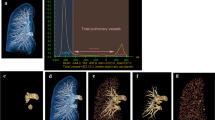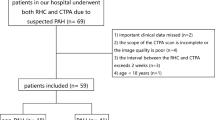Abstract
Background
The effect of cardiac phase on CT pulmonary vascular volumetry is unknown.
Objective
To evaluate the effect of cardiac phase on CT pulmonary vascular volume ratio in children and young adults with congenital heart disease.
Materials and methods
Thirty-one children and young adults (median age 14 years) with congenital heart disease underwent electrocardiography-synchronized cardiothoracic CT at the end-systolic and end-diastolic phases as well as lung perfusion scintigraphy (n=20) or cardiac MRI (n=11). The author calculated right and left pulmonary vascular volumes by using threshold-based CT volumetry. Right pulmonary vascular volume percentages measured by CT obtained at the end-systolic and end-diastolic phases were compared with corresponding values measured by the reference method (lung perfusion scintigraphy or phase-contrast MRI) by using paired t-test and Bland–Altman analysis.
Results
The right pulmonary vascular volume percentages measured by CT were significantly greater at the end-systolic phase than at the end-diastolic phase (64.0±14.1% vs. 61.9±10.7%; P<0.01). The end-systolic CT right pulmonary vascular volume percentages were not significantly different from the corresponding values measured by the reference method (64.0±14.1% vs. 65.3±13.6%; P>0.05), while the end-diastolic vascular volume percentages were significantly smaller than the corresponding values measured by the reference method (61.9±10.7% vs. 65.3±13.6%; P=0.01). Bland–Altman analysis showed a mean difference of 1.4±7.2% for the end-systolic CT, which was significantly smaller than that for the end-diastolic CT (3.4±7.0%; P<0.01).
Conclusion
The CT pulmonary vascular volume ratio is significantly influenced by the cardiac phase of cardiothoracic CT. The end-systolic phase offers more accurate CT pulmonary vascular volumes than the end-diastolic phase.



Similar content being viewed by others
References
Vida VL, Rito ML, Zucchetta F et al (2013) Pulmonary artery branch stenosis in patients with congenital heart disease. J Card Surg 28:439–445
Sabiniewicz R, Romanowicz G, Bandurski T et al (2002) Lung perfusion scintigraphy in the diagnosis of peripheral pulmonary stenosis in patients after repair of Fallot tetralogy. Nucl Med Rev Cent East Eur 5:11–13
Fratz S, Hess J, Schwaiger M et al (2002) More accurate quantification of pulmonary blood flow by magnetic resonance imaging than by lung perfusion scintigraphy in patients with fontan circulation. Circulation 106:1510–1513
Roman KS, Kellenberger CJ, Farooq S et al (2005) Comparative imaging of differential pulmonary blood flow in patients with congenital heart disease: magnetic resonance imaging versus lung perfusion scintigraphy. Pediatr Radiol 35:295–301
Sridharan S, Derrick G, Deanfield J, Taylor AM (2006) Assessment of differential branch pulmonary blood flow: a comparative study of phase contrast magnetic resonance imaging and radionuclide lung perfusion imaging. Heart 92:963–968
Goo HW (2011) Cardiac MDCT in children: CT technology overview and interpretation. Radiol Clin N Am 49:997–1010
Tsai IC, Goo HW (2013) Cardiac CT and MRI for congenital heart disease in Asian countries: recent trends in publication based on scientific database. Int J Card Imaging 29:1–5
Goo HW (2013) Current trends in cardiac CT in children. Acta Radiol 54:1055–1062
Koch K, Oellig F, Oberholzer K et al (2005) Assessment of right ventricular function by 16-detector-row CT: comparison with magnetic resonance imaging. Eur Radiol 15:312–318
Kim HJ, Goo HW, Park S, Yun TJ (2013) Left ventricle volume measured by cardiac CT in two infants with small left ventricles: a new and accurate method in determining uni- or biventricular repair. Pediatr Radiol 43:243–246
Goo HW, Park SH (2015) Semiautomatic three-dimensional CT ventricular volumetry in patients with congenital heart disease: agreement between two methods with different user interaction. Int J Card Imaging 31:223–232
Goo HW (2017) Serial changes in anatomy and ventricular function on dual-source cardiac CT after Norwood procedure for hypoplastic left heart syndrome. Pediatr Radiol 47:1776–1786
Goo HW, Park SH (2017) Pulmonary vascular volume ratio measured by cardiac computed tomography in children and young adults with congenital heart disease: comparison with lung perfusion scintigraphy. Pediatr Radiol 47:1580–1587
Goo HW, Allmendinger T (2017) Combined ECG- and respiratory-triggered CT of the lung to reduce respiratory misregistration artifacts between imaging slabs in free-breathing children: initial experience. Korean J Radiol 18:860–866
Goo HW (2011) Individualized volume CT dose index determined by cross-sectional area and mean density of the body to achieve uniform image noise of contrast-enhanced pediatric chest CT obtained at variable kV levels and with combined tube current modulation. Pediatr Radiol 41:839–847
Goo HW (2018) Comparison of chest pain protocols for electrocardiography-gated dual-source cardiothoracic CT in children and adults: the effect of tube current saturation on radiation dose reduction. Korean J Radiol 19:23–31
Goo HW (2012) CT radiation dose optimization and estimation: an update for radiologists. Korean J Radiol 13:1–11
Hui P, Goo HW, Du J et al (2017) Asian consortium on radiation dose of pediatric cardiac CT (ASCI-REDCARD). Pediatr Radiol 47:899–910
Goo HW, Al-Otay A, Grosse-Wortmann L et al (2009) Phase contrast MR quantification of normal pulmonary venous return. J Magn Reson Imaging 29:588–594
Shariat M, Schantz D, Yoo SJ et al (2014) Pulmonary artery pulsatility and effect on vessel diameter assessment in magnetic resonance imaging. Eur J Radiol 83:378–383
Voser EM, Kellenberger CJ, Buechel ER (2013) Effects of pulmonary regurgitation on distensibility and flow of the branch pulmonary arteries in tetralogy of Fallot. Pediatr Cardiol 34:1118–1124
Harris MA, Whitehead KK, Gillespie MJ et al (2011) Differential branch pulmonary artery regurgitation fraction is a function of differential pulmonary artery anatomy and pulmonary vascular resistance. JACC Cardiovasc Imaging 4:506–513
Valverde I, Nordmeyer S, Uribe S et al (2012) Systemic-to-pulmonary collateral flow in patients with palliated univentricular heart physiology: measurement using cardiovascular magnetic resonance 4D velocity acquisition. J Cardiovasc Magn Reson 14:25
Hayabuchi Y, Inoue M, Watanabe N et al (2010) Assessment of systemic-pulmonary collateral arteries in children with cyanotic congenital heart disease using multidetector-row computed tomography: comparison with conventional angiography. Int J Cardiol 138:266–271
Goo HW (2004) Evaluation of the airways in patients with congenital heart disease using multislice CT. J Korean Pediatr Cardiol Soc 8:37–43
Goo HW, Seo DM, Yun TJ et al (2009) Coronary artery anomalies and clinically important anatomy in patients with congenital heart disease: multi-slice CT findings. Pediatr Radiol 39:265–273
Goo HW (2011) Haemodynamic findings on cardiac CT in children with congenital heart disease. Pediatr Radiol 41:250–261
Goo HW (2015) Coronary artery imaging in children. Korean J Radiol 16:239–250
Goo HW (2017) Myocardial delayed enhancement CT: initial experience in children and young adults. Pediatr Radiol 47:1452–1462
Author information
Authors and Affiliations
Corresponding author
Ethics declarations
Conflicts of interest
None
Rights and permissions
About this article
Cite this article
Goo, H.W. Computed tomography pulmonary vascular volume ratio in children and young adults with congenital heart disease: the effect of cardiac phase. Pediatr Radiol 48, 915–922 (2018). https://doi.org/10.1007/s00247-018-4120-1
Received:
Revised:
Accepted:
Published:
Issue Date:
DOI: https://doi.org/10.1007/s00247-018-4120-1




